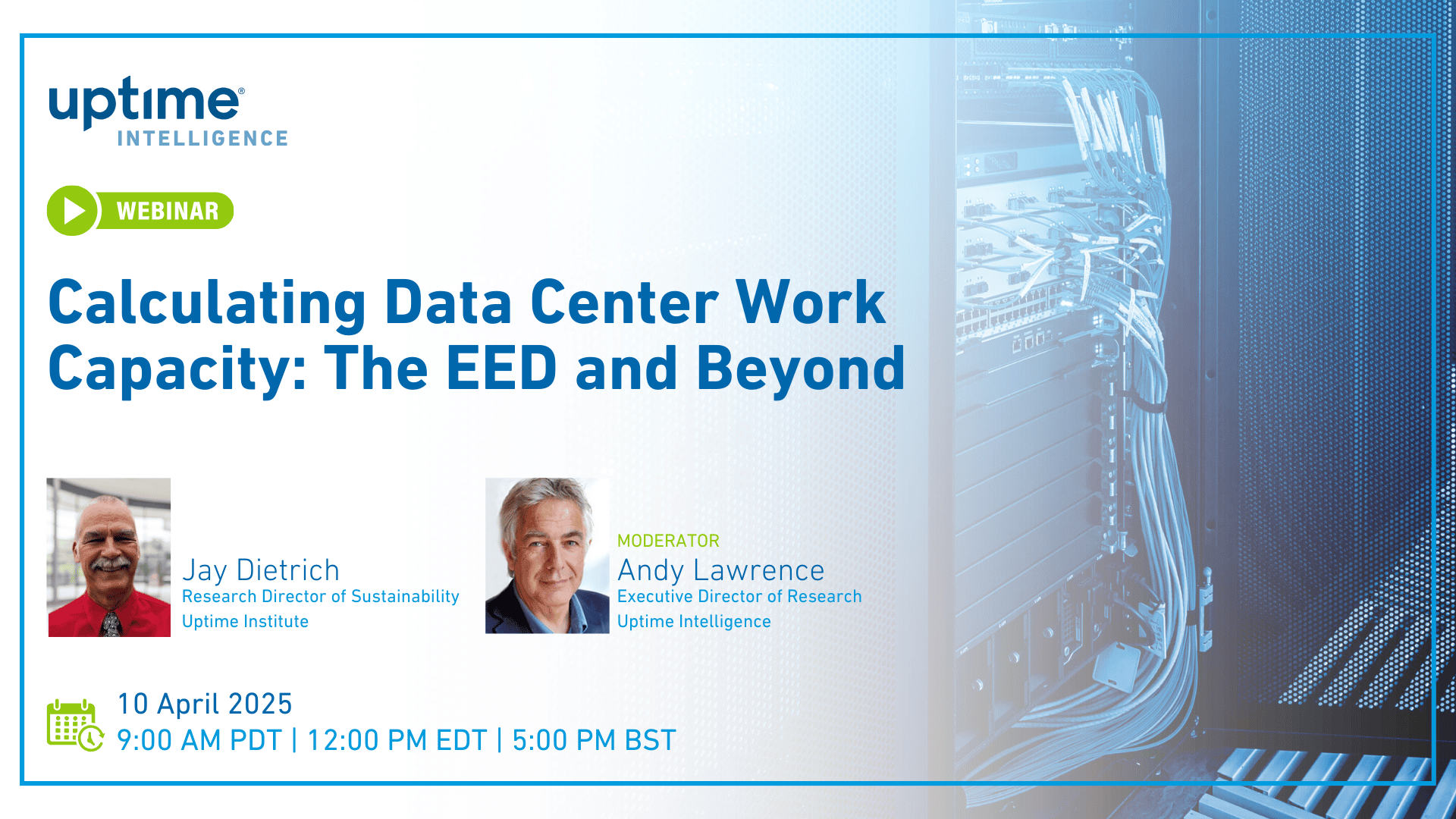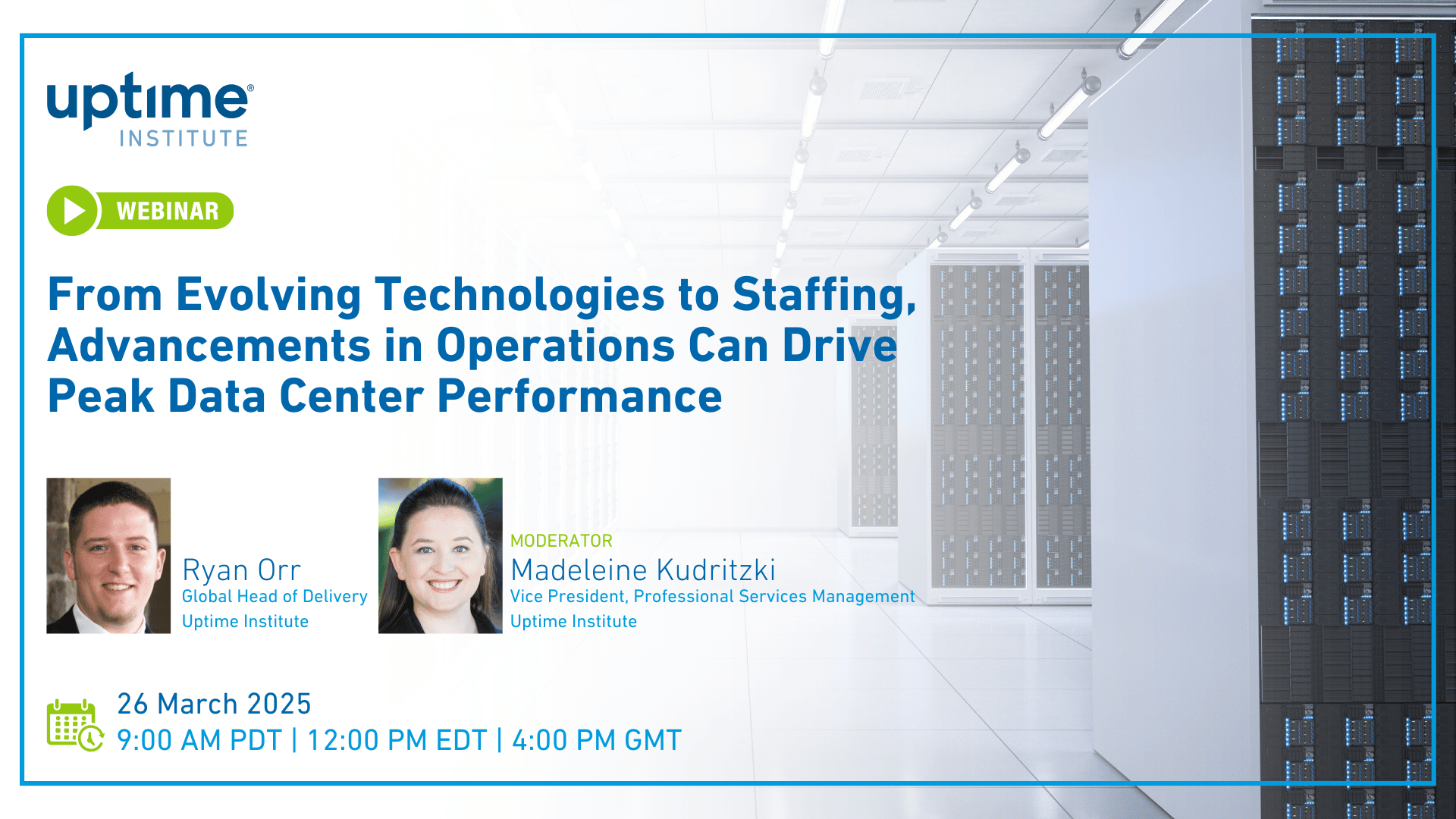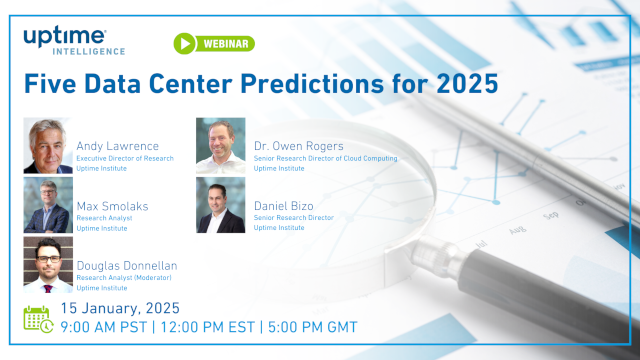Webinar: 2019 Resultados da Pesquisa da industria de data centers
Título da apresentação:
Resultados da pesquisa do setor de data centers do Uptime Institute 2019
Apresentadores:
Andy Lawrence, Diretor Executivo, Pesquisa
Rhonda Ascierto, vice-presidente de pesquisa
Christopher Brown, Diretor Técnico
Resumo:
Os maiores e mais influentes resultados da pesquisa do setor de data centers estão presentes. Junte-se a nós para ver as tendências. Os data centers estão ficando mais eficientes? Como as interrupções estão mudando? Que proporção das cargas de trabalho estão sendo executadas na nuvem? A densidade do rack aumentará por último?
| Pergunta do público | Resposta do Uptime Institute |
|---|---|
| Os números mostram que a PUE não melhorou recentemente, mas a densidade do rack está aumentando. Eu presumiria que uma maior densidade de rack melhoraria a PUE. Alguma ideia sobre isso? | Em teoria, um aumento na densidade do rack resultaria em um aumento na temperatura do ar de retorno, o que resulta em um aumento na temperatura diferencial do lado do ar e pode resultar nos sistemas de refrigeração funcionando com mais eficiência. No entanto, na prática, não testemunhei isso funcionando porque há muito com o design que entra em jogo, como há contenção para limitar a mistura de fornecimento e retorno de ar, juntamente com como o sistema elétrico está operando para realmente resultar em uma diminuição na PUE. |
| 1. E quanto às métricas baseadas em eficiência: Eficiência da infraestrutura do data center (DCiE) 2. Além disso, métricas baseadas em recursos: - Intensidade de carbono (CUE) - Utilização de água (WUE) |
Como humanos, gostamos de métricas. Eles podem ser medidos e relatados automaticamente. Eles são bons indicadores de desempenho, desde que as métricas sendo usadas sejam adaptadas para o data center individual e as necessidades e desejos da empresa. Por exemplo, se um data center estiver localizado onde a água potável é abundante e o monitoramento barato, a WUE pode informar sobre como está utilizando a água para o meio ambiente, mas pode não importar muito para os custos gerais do data center. É por isso que alertei contra o uso de apenas PUE como uma métrica de quão eficiente o data center está operando, pois pode mostrar uma operação eficiente, mas outras métricas podem mostrar o consumo excessivo de energia ou ativos de TI que resultam em custos operacionais mais altos. É importante sempre ter em mente quais são as metas da empresa em relação à eficiência. |
| O que você define como cargas de missão crítica? | Os data centers são construídos para apoiar uma necessidade de negócios. Cargas de missão crítica são as cargas necessárias para a operação do negócio e sem as quais o negócio seria afetado negativamente ou até mesmo interrompido. |
| Qual é a sua definição de "Empresa"? | Acredito que você esteja se referindo ao nosso uso do termo Enterprise Data Center. Neste caso, um data center corporativo é um data center que pertence a uma empresa para dar suporte às suas próprias necessidades de TI. Não é baseado no tamanho da empresa apenas que o data center é de propriedade da empresa e está sendo usado para atender às suas próprias necessidades de TI. |
| O que você acha que as empresas, os centros de distribuição, os centros de distribuição e seus principais participantes no centro de distribuição com virtualização e consolidação tradicionais precisam ouvir para se tornarem (mais) mentes abertas para machine learning/análises preditivas que poderiam afetar positivamente sua infraestrutura de energia e potencialmente aumentar a densidade do rack e melhorar sua infraestrutura de energia? | A Pesquisa Anual Global 2018 do Uptime Institute mostrou que 70% dos fornecedores, consultores e vendedores pesquisados acreditam que a IA será amplamente usada no data center. A complexidade e a escala dos data centers modernos, juntamente com a rápida velocidade de mudança nos ambientes de TI, estão se tornando muito grandes para os humanos gerenciarem com eficácia. Para computadores e inteligência artificial, no entanto, pode ser relativamente simples. Um objetivo importante é prever e prevenir incidentes e detectar e remediar ineficiências e deficiências de capacidade. Considerando que muitos data centers são utilizados de forma subideal, muitas operadoras provavelmente se beneficiarão da tecnologia. |
| Você menciona que as redes são o segundo maior motivo para o tempo de inatividade. Qual é o problema? Isso é um problema com a qualidade dos equipamentos que os fabricantes de equipamentos de rede estão fornecendo? |
Nesta pesquisa e em outras pesquisas, o Uptime Institute viu um aumento claro nas falhas devido a incidentes de networking. Os dados também sugerem que as interrupções relacionadas à TI/rede podem levar mais tempo para serem corrigidas do que as interrupções nas instalações de energia/data center. |
| Dado que 12% dos entrevistados eram de serviços de software/nuvem, 16% eram de telecomunicações e 26% eram colo/multilocatário, você acha que a discussão sobre nuvem precisa ser mais sutil? Um provedor de colo que responde a "onde colocamos cargas de trabalho críticas" não está respondendo da mesma forma que os entrevistados corporativos. Possivelmente isso já foi contabilizado? | Sim, nossa análise detalhada é mais detalhada. Durante o webinar, compartilhamos apenas uma amostra dos principais pontos de dados. Resultados mais detalhados da pesquisa e a oportunidade de discutir descobertas diretamente com a equipe do Uptime Institute Intelligence estão disponíveis para os membros da Uptime Institute Network. |
| Quais técnicas estão disponíveis para gerenciar proativamente o desempenho e a eficiência? | DCIM, DMaaS e outras abordagens baseadas em IA são ótimas maneiras de gerenciar proativamente o desempenho e a eficiência. |
| Embora a questão da resiliência seja claramente uma grande preocupação e os desafios continuem, você acha que os executivos também estão olhando para o aspecto da utilização dos ativos do data center à medida que fazem outros recursos em suas empresas, sejam físicos ou humanos? | Sim, embora não seja incomum que os executivos aceitem baixas taxas de utilização de ativos de data center como uma compensação para alta resiliência ou a governança de controle/dados que vem com a propriedade de uma instalação privada. Em instalações privadas e de terceiros, como colocation, também é comum que as taxas de utilização nem mesmo sejam rastreadas. Estamos, no entanto, lentamente começando a ver mais data centers adotarem abordagens de energia definidas por software que permitem maior utilização de ativos (por meio de mudança/deslocamento de carga e/ou com acordos transativos com concessionárias locais). Em termos gerais, os recursos humanos estão em falta em todo o setor – a baixa utilização não é um problema sobre o qual ouvimos falar. |
| No slide re: escassez de habilidades no data center, o fornecimento de pessoal da função de força ou orçamento organizacional? Com base na linguagem de "cortes", este slide está possivelmente vendo uma expectativa de gerenciamento de mais efeitos de automação e busca dessas oportunidades? | O que ouvimos repetidamente em todo o setor é que o suprimento de pessoal é a função de força. Isso é particularmente preocupante devido ao acinzentamento do setor. Os cortes de pessoal são frequentemente o resultado da mudança de data centers privados locais para instalações de terceiros, como colo e nuvem. No entanto, mesmo os hiperescaladores estão lutando para preencher posições abertas. Em termos de automação, perguntamos apenas sobre IA (intimamente relacionada). Während der Patentzeit darf kein anderes Unternehmen das gleiche Produkt auf den Markt bringen. Wo kann ich beide Medikamente beantragen. Die Dauer der Wirkung beträgt zwischen 24 und 36 Stunden. Durch das cGMP erschlaffen morre glatten Muskelzellen im Schwellkörper. Präparate Potenzmittel Kamagra 100 mg ohne Rezept sind recht kostspielig und manchem Verbraucher viel zu teuer. Schwerverdauliches Essen kann morre Wirkung abschwächen. Wie wirken die Medikamente für die Beseitigung der erektilen Disfunktion. Em resposta à pergunta, você acredita que a inteligência artificial (IA) reduzirá os níveis de pessoal das operações do seu data center nos próximos 5 anos? 29% disseram sim, 42% disseram sim, mas em mais de 5 anos, e 29% disseram não. Em termos gerais, IA e automação são metas de curto ou médio prazo para muitos operadores de data center. |
| Como você está definindo "interrupção"? | Em termos gerais, definimos uma interrupção como uma interrupção do serviço. Dentro dessa definição ampla, também classificamos interrupções específicas pelo impacto da interrupção. Definimos essas classificações em mais detalhes na tabela de classificação de gravidade de interrupções do Uptime Institute aqui:https://uptimeinstitute.com/resources/outage-severity-rating |
| Tem dúvidas sobre o webinar? Envie um e-mail para info@uptimeinstitute.com | |





